Description
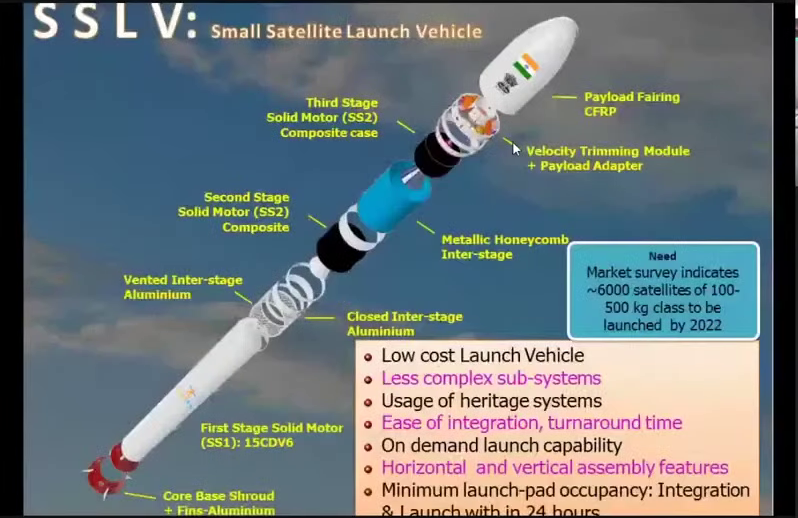
Disclaimer: Copyright infringement not intended.
Context
- The Indian Space Research Organisation (ISRO) will undertake the maiden flight of its newly developed Small Satellite Launch Vehicle (SSLV) on August 7.
Launch vehicle
- A launch vehicle or carrier rocket is a rocket-propelled vehicle used to carry a payload from Earth's surface to space, usually to Earth orbit or beyond.
SSLV
- About: The Small Satellite Launch Vehicle (or SSLV) is a small-lift launch vehicle being developed by the Indian Space Research Organisation (ISRO).
- Aim: The SSLV was developed with the aim of launching small satellites commercially at drastically reduced price and higher launch rate as compared to Polar Satellite Launch Vehicle (PSLV).
- Capacity and Features: It has a payload capacity to deliver 600 kg. SSLV is a three-stage, all-solid launch vehicle that can carry a payload weighing 500 kilograms to the polar orbit, 500 kilometers above Earth's surface and a 300-kilogram payload into Sun Synchronous Polar Orbit. It has the capability to support multiple orbital drop-offs. The SSLV is the smallest vehicle at 110-ton mass at ISRO. It can carry satellites weighing up to 500 kg to a low earth orbit while the tried and tested PSLV can launch satellites weighing in the range of 1000 kg.
Evolution of India’s Launch Vehicles
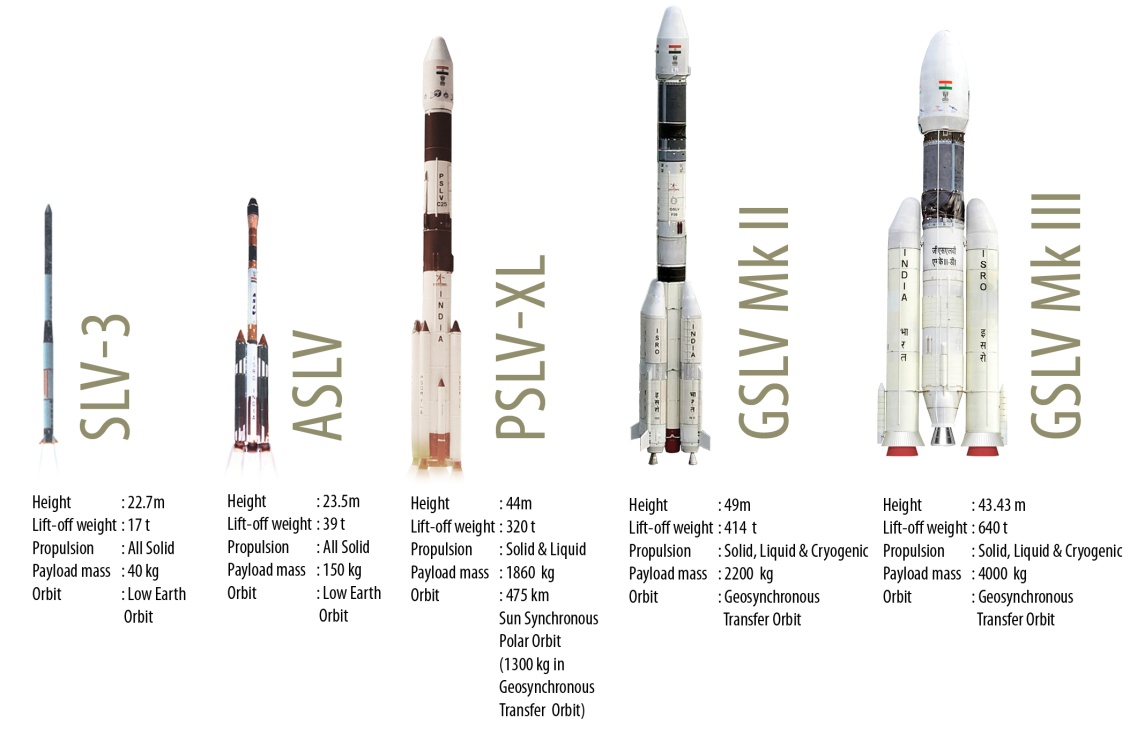
Why do we need launch vehicles?
- Satellites don’t go into the space on their own. They are carried there by launch vehicles, or rockets, like the PSLV.
- The rockets have powerful propulsion systems that generate the huge amount of energy required to lift heavy objects like satellites into space, overcoming the gravitational pull of the earth.
The process
- Satellites, or payloads as they are often called, sit inside the rocket, and are ejected once they reach near their intended orbit in space.
- Both rockets and satellites are spacecraft - as spacecraft is a generic term used for any object that is sent into space.
- Satellites carry one or more instruments that do the scientific work for which they are sent into space. Their operational life sometimes extends up to decades.
- Rockets, or launch vehicles, become useless after the launch. Their only job is to take the satellites to their intended orbits.
What happens to these launch vehicles then?
- Rockets have several detachable energy-providing parts. They burn different kinds of fuels to power the rocket.
- Once their fuel is exhausted, they detach from the rocket and fall off, often burning off in the atmosphere due to air-friction, and getting destroyed.
- Only a small part of the original rocket goes till the intended destination of the satellite.
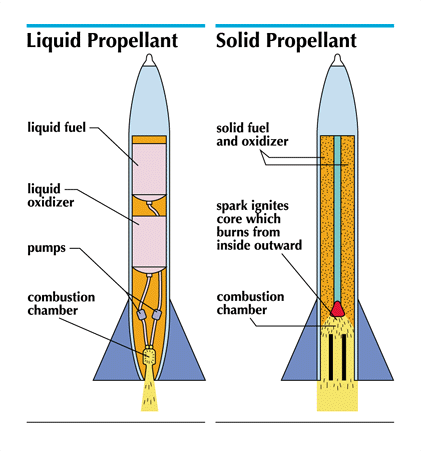
- Once the satellite is finally ejected, this last part of the rocket either becomes part of space debris, or once again burns off after falling into the atmosphere.
|
Types of Propellants in Rockets
|
Propulsion system in satellites
- Most satellites have small propulsion systems and carry small amounts of fuel, because they encounter very little drag, or force, in outer space.
Types of launch vehicles/Rockets
- Several kinds of rockets are used to carry satellites.
- The difference is mainly in the power that they can generate, the weight they can carry, and the distance they can travel into space, all of which are related.
- It all comes down to the energy that is generated, which is a function of how efficient the engine and the fuel is.
For Low Earth Orbit
- Several satellites need to be deposited only in the lower earth orbits, which starts from about 180 km from earth’s surface and extends up to 2,000 km.
- Most of the earth-observation satellites, communication satellites, and even the International Space Station, a full-fledged laboratory in space that hosts astronauts, function in this space.
- It takes smaller amount of energy to take the satellites to the low-earth orbits, and accordingly smaller, less powerful, rockets are used for this purpose.
For higher orbits
- There are satellites which need to go much deeper in space. Geostationary satellites, for example, have to be deposited in orbits that are about 36,000 km from earths’ surface.
- The planetary exploration missions also need their rockets to leave them much deeper in space. For such space missions, much more powerful rockets are used.
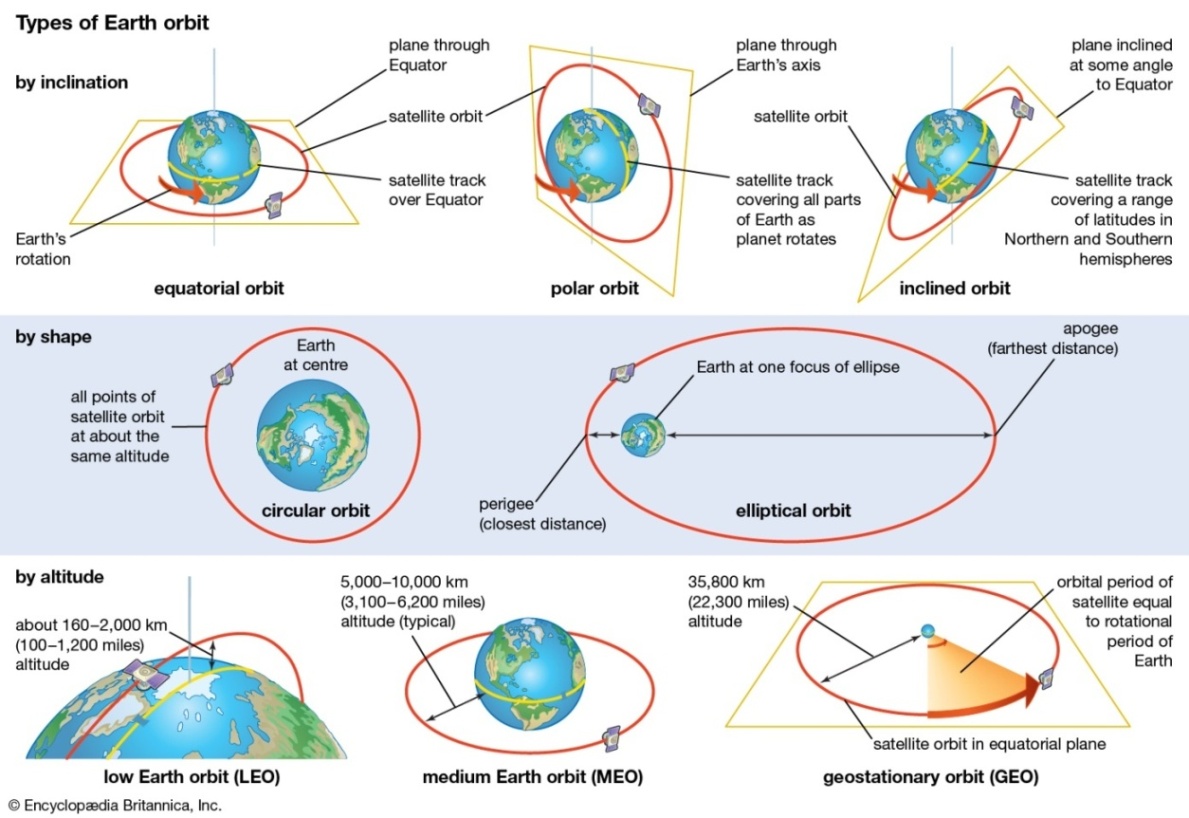
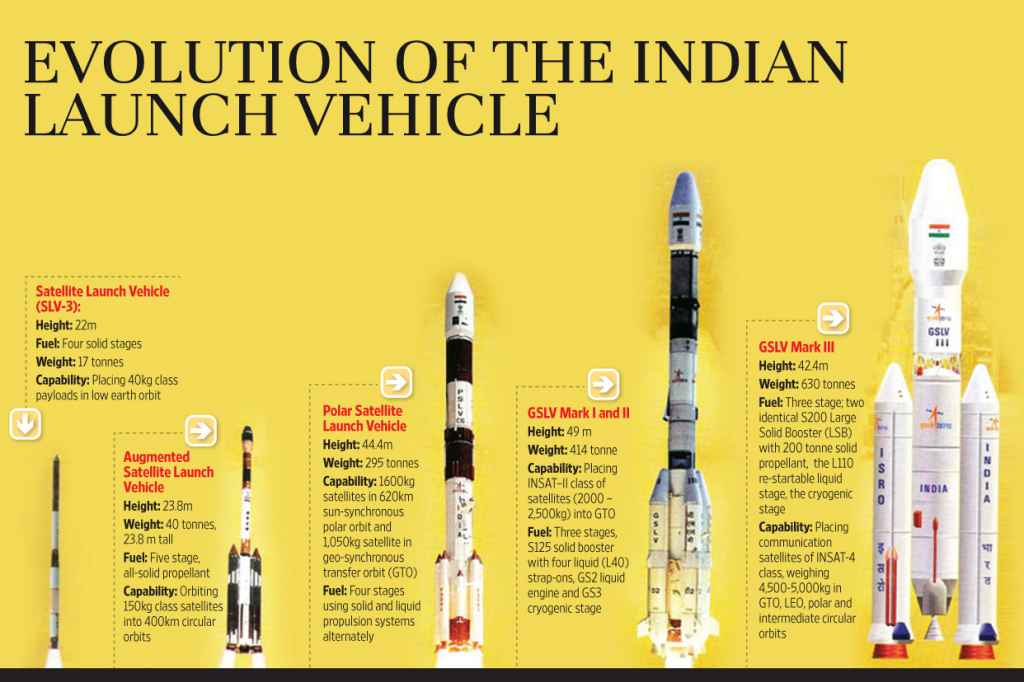
ISRO’s Launch Vehicles
SLV
- Satellite Launch Vehicle-3 (SLV-3) was India's first experimental satellite launch vehicle.
- It was an all solid, four stage vehicle weighing 17 tonnes with a height of 22m and capable of placing 40 kg class payloads in Low Earth Orbit (LEO).
- SLV-3 was successfully launched on July 18, 1980 from Sriharikota when Rohini satellite, RS-1 carrying remote sensing sensors, was placed in orbit, thereby making India the sixth member of an exclusive club of space-faring nations.
- The successful culmination of the SLV-3 project showed the way to advanced launch vehicle projects such as the Augmented Satellite Launch Vehicle (ASLV), Polar Satellite Launch Vehicle (PSLV) and the Geosynchronous satellite Launch Vehicle (GSLV).
ASLV
- The Augmented Satellite Launch Vehicle or Advanced Satellite Launch Vehicle, also known as ASLV, was a Small-lift launch vehicle five-stage solid-fuel rocket developed to place 150 kg satellites into 400 km circular LEO.
- The capacity was thrice that of SLV-3, for Low Earth Orbits (LEO). It was operated till 1990 before the arrival of PSLV.
PSLV
- Polar Satellite Launch Vehicle (PSLV) is the third generation launch vehicle of India. It is the first Indian launch vehicle to be equipped with liquid stages.
- It is an expendable medium-lift launch vehicle.
- It was developed to allow India to launch its Indian Remote Sensing (IRS) satellites into sun-synchronous orbits – a service that until the advent of the PSLV in 1993, was commercially available only from Russia.
- PSLV can also launch small size satellites into Geostationary Transfer Orbit (GTO).
- Some notable payloads launched by PSLV include India's first lunar probe Chandrayaan-1, India's first interplanetary mission, Mars Orbiter Mission (Mangalyaan) and India's first space observatory, Astrosat.

GSLV
- Geosynchronous Satellite Launch Vehicle (GSLV) is a space launch vehicle developed to launch satellites and other space objects into Geosynchronous Transfer Orbits.
- Geosynchronous Satellite Launch Vehicle (or GSLV) is a three-stage launcher with strap-on motors.
- GSLV has the capability to put a heavier payload in the orbit than the Polar Satellite Launch Vehicle (PSLV). It can take 10,000-kg satellites to lower earth orbits.
- First Stage: GS1
The first stage uses solid rocket motor with four liquid engine strap-on motors. This stage generates maximum thrust of 4700 kilo Newton.
- Second Stage: GS2
The second stage uses a liquid rocket engine which is known as Vikas engine. It generates maximum thrust of 800 kilo Newton.
The third stage uses a Cryogenic engine, which uses liquefied oxygen and hydrogen as fuel.
Capability
Payload to GTO: 4,000 kg
Payload to LEO: 8000 kg
SSLV
- The Small Satellite Launch Vehicle (SSLV) is a small-lift launch vehicle being developed by the Indian Space Research Organisation (ISRO).
- It has a payload capacity to deliver 600 kg (1,300 lb) to low Earth orbit (500 km) or 300 kg to Sun-synchronous orbit (500 km ) for launching small satellites, with the capability to support multiple orbital drop-offs.
- The SSLV was developed with the aim of launching small satellites commercially at drastically reduced price and higher launch rate as compared to Polar Satellite Launch Vehicle (PSLV).
- It is supposed to carry an indigenous earth observation satellite EOS-03 into space.
Reusable rockets
- In reusable rockets, only a small part of the rocket would be destroyed during the mission.
- The bulk of it would re-enter the earth’s atmosphere and land very much like an airplane, and can be used in future missions.
- Reusable rockets would cut down on costs and energy, and also reduce space debris, which is becoming a serious problem because of the large number of launches.
- Fully-reusable rockets are still to be developed, but partially-reusable launch vehicles are already in use.
- ISRO has also developed a reusable rocket, called RLV-TD (Reusable Launch Vehicle Technology Demonstrator) which has had a successful test flight in 2016.
WATCH:
https://www.youtube.com/watch?v=wrNNbSV8zkA
https://www.youtube.com/watch?v=3hz3J26P5IQ
Read: https://www.iasgyan.in/blogs/types-of-orbits-explained
Read: https://www.iasgyan.in/blogs/the-basics-of-missiles
1.png)















